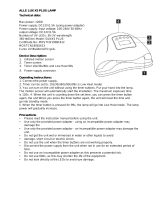
Contents
1. Introduction....................................................................4
1.1 Block diagram of the DSP software.................................................4
2. The D6 operating software.............................................5
2.1 Menu tree..........................................................................................5
2.2 User interface....................................................................................6
2.2.1 Conventions for the cursor and menu control........................6
2.3 Boot screen........................................................................................7
2.4 Main screen.......................................................................................7
2.5 Settings menu....................................................................................8
Input..........................................................................................8
Channel A (B)...........................................................................8
Setup Channel A (B)..............................................................9
Source (Input routing)......................................................9
Speaker............................................................................9
Filter_1, Filter_2, Filter_3..............................................10
Equalizer........................................................................10
Delay.............................................................................11
Levels.............................................................................12
Channel Name..............................................................13
System Check................................................................14
Load Monitoring...........................................................15
Frequency Generator....................................................17
Link A»B..................................................................................18
AmpPreset..............................................................................18
Remote...................................................................................20
Lock........................................................................................20
Options...................................................................................21
Device Name......................................................................22
Display.................................................................................22
Information...........................................................................23
Log.................................................................................23
Channel A (B)................................................................24
Input Monitoring..................................................................25
Important notes on Input Monitoring...........................25
Input Monitoring menu.................................................26
Power Supply......................................................................27
Buzzer..................................................................................27
2.6 Display messages...........................................................................28
2.6.1 Error messages......................................................................28
2.6.2 System Check, Load and Input Monitoring..........................29
2.6.3 Error messages during operation.........................................29
2.6.4 Further messages...................................................................30
2.7 System Reset...................................................................................30
3. D6 Firmware update.....................................................31
3.1 Serial update with R1.....................................................................31
3.2 Firmware update via CAN-Bus with R1.........................................31
D6 Software manual (1.4 en) Contents - 1





















